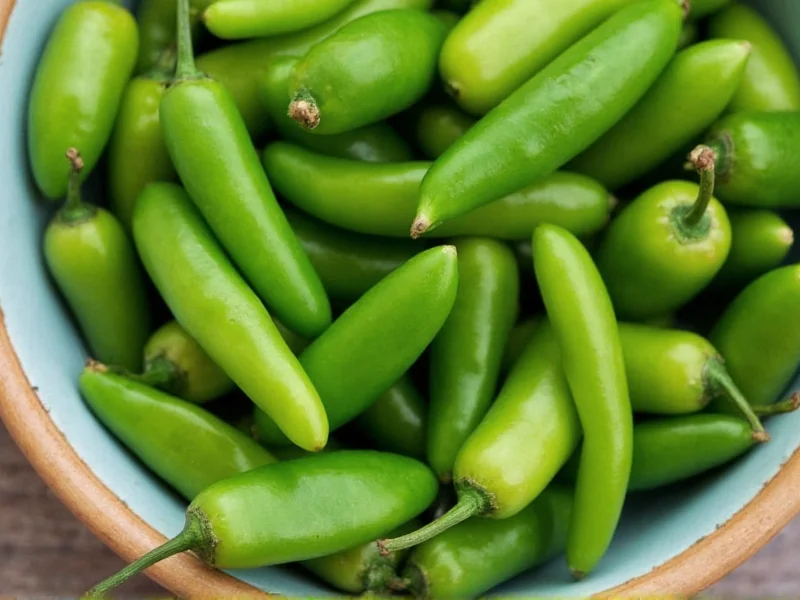Understanding the precise heat level of jalapeños is essential for both cooking enthusiasts and spice lovers. The Scoville scale, developed by pharmacist Wilbur Scoville in 1912, measures the concentration of capsaicin—the compound responsible for a pepper's heat—in Scoville Heat Units (SHU). While many people assume jalapeños have a fixed heat level, their actual spiciness varies significantly based on several factors. This natural variation explains why you might experience dramatically different heat levels between two seemingly identical jalapeños from the same grocery store.
Why Jalapeños Have a Range of Heat Levels
Jalapeños don't have a single Scoville rating because multiple variables affect their capsaicin content. Unlike laboratory-created substances, peppers are natural products influenced by their growing conditions. The 2,500-8,000 SHU range reflects this natural variability rather than measurement inconsistency. When discussing how many scovilles is jalapeno, it's crucial to understand this range represents biological variation, not measurement error.
Factors That Influence Jalapeño Heat
Several key elements determine where a particular jalapeño falls within the Scoville range:
| Factor | Effect on Heat Level |
|---|---|
| Stress during growth | Peppers become hotter when experiencing water stress or temperature fluctuations |
| Ripeness | Red jalapeños (fully ripe) are typically hotter than green ones |
| Genetic variation | Different jalapeño cultivars have varying heat potentials |
| Seed and membrane content | Most capsaicin resides in the white pith and seeds |
How Jalapeños Compare to Other Common Peppers
Understanding where jalapeños sit on the Scoville scale provides valuable context for cooking and spice tolerance. Here's how they compare to other popular peppers when considering how many scoville units is a jalapeno:
| Pepper Type | Scoville Heat Units (SHU) | Relative Heat |
|---|---|---|
| Bell Pepper | 0 SHU | No heat |
| Jalapeño | 2,500-8,000 SHU | Mild to medium |
| Serrano | 10,000-23,000 SHU | Medium to hot |
| Habanero | 100,000-350,000 SHU | Very hot |
| Ghost Pepper | 855,000-1,041,427 SHU | Extremely hot |
Practical Implications for Cooking with Jalapeños
Knowing that jalapeños range from 2,500 to 8,000 Scoville units helps cooks make informed decisions. For those sensitive to spice, selecting greener jalapeños and removing the seeds and white membranes can significantly reduce heat. Conversely, gardeners seeking hotter jalapeños can introduce mild stress to their plants during growth.
The moderate heat level of jalapeños makes them versatile for various cuisines. They provide noticeable spice without overwhelming other flavors, which explains their popularity in salsas, nachos, and stuffed pepper dishes. When substituting jalapeños in recipes, consider that a single extremely hot jalapeño (approaching 8,000 SHU) can be nearly three times spicier than a mild one (around 2,500 SHU). This knowledge helps answer the common question about how many scoville units is a jalapeno in practical cooking scenarios.
Measuring Pepper Heat: From Human Testing to Modern Methods
Originally, the Scoville scale relied on human taste testers diluting pepper extract until the heat became undetectable. Today, high-performance liquid chromatography (HPLC) provides precise measurements of capsaicinoids, which are then converted to Scoville units. This modern approach explains why we can now provide more accurate ranges for peppers like jalapeños. Understanding the science behind how many scovilles is jalapeno helps consumers appreciate the precision behind these measurements.
Common Misconceptions About Jalapeño Heat
Several myths persist about jalapeño heat levels. Many believe that smaller jalapeños are always hotter, but size correlates weakly with actual heat. The presence of striations (light-colored stretch marks) on the pepper's surface does indicate higher stress during growth and often corresponds with greater heat, but this isn't a perfect predictor.
Another common misunderstanding is that all jalapeños from the same plant will have identical heat. In reality, even peppers from the same plant can vary significantly in Scoville units due to their position on the plant and exposure to environmental factors. This variation explains why the question of how many scovilles is jalapeno doesn't have a single numerical answer.
Frequently Asked Questions
What is the average Scoville rating for a jalapeño pepper?
The average jalapeño pepper measures around 5,000 Scoville Heat Units (SHU), though they can range from 2,500 to 8,000 SHU depending on growing conditions and specific variety.
Why do jalapeños have a range of Scoville units instead of a fixed number?
Jalapeños have a range because their heat level depends on multiple factors including growing conditions, ripeness, and genetic variation. Unlike laboratory-created substances, peppers are natural products affected by environmental stressors, water availability, and sunlight exposure.
How does the heat of a jalapeño compare to other common peppers?
Jalapeños (2,500-8,000 SHU) are significantly milder than habaneros (100,000-350,000 SHU) but hotter than poblano peppers (1,000-2,000 SHU). They're about 2-4 times hotter than poblanos but 12-40 times milder than habaneros.
Can you predict how hot a jalapeño will be before tasting it?
While not perfectly predictable, certain visual cues can indicate higher heat potential. Jalapeños with visible striations (light-colored stretch marks), thinner walls, and a more mature red color tend to be hotter than smooth, thick-walled green peppers.
Does removing seeds and membranes reduce a jalapeño's Scoville rating?
Yes, removing the seeds and white membranes (placenta) can reduce a jalapeño's perceived heat by up to 80%, as these parts contain the highest concentration of capsaicin. However, the Scoville rating itself remains the same; you're simply removing the hottest parts.











 浙公网安备
33010002000092号
浙公网安备
33010002000092号 浙B2-20120091-4
浙B2-20120091-4